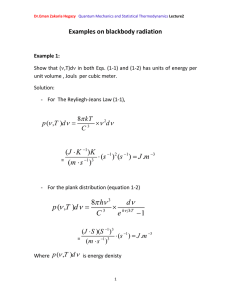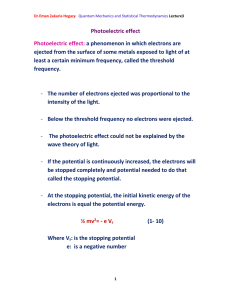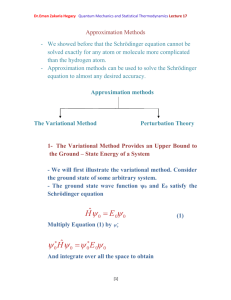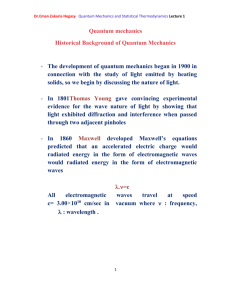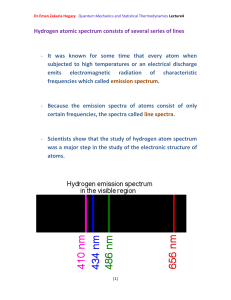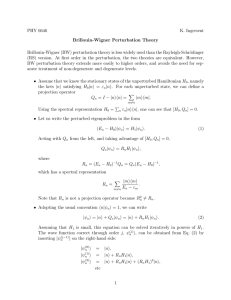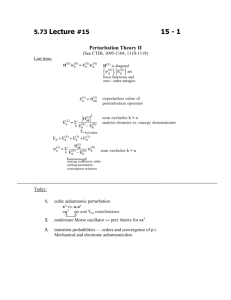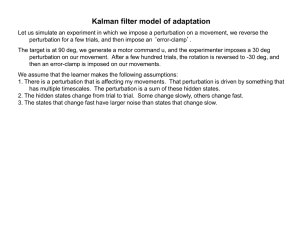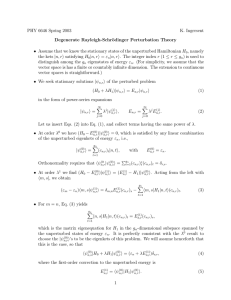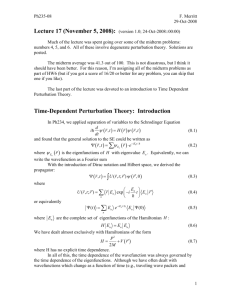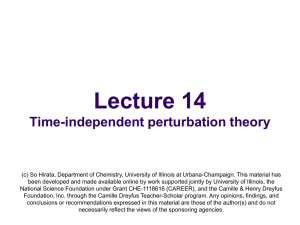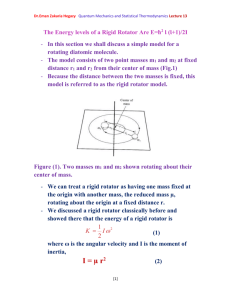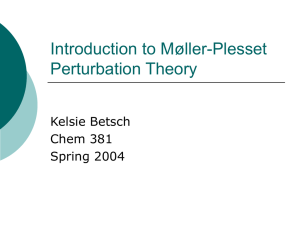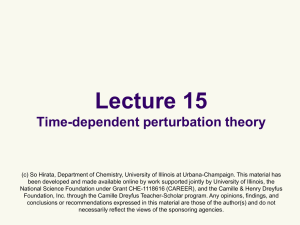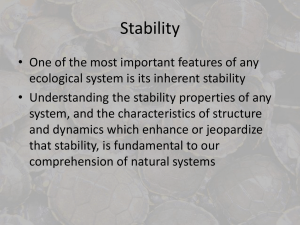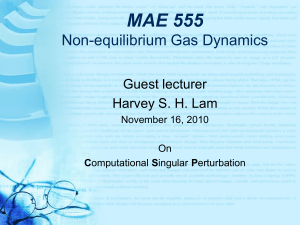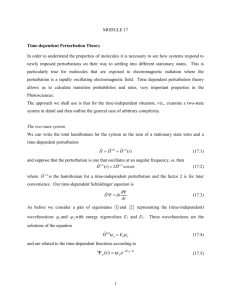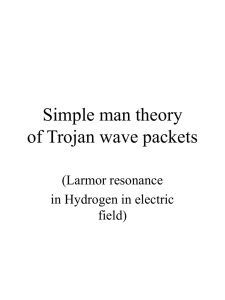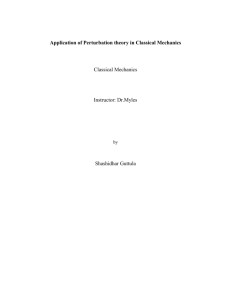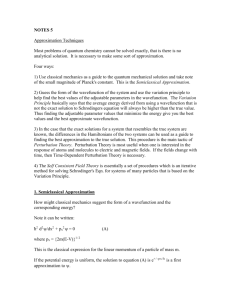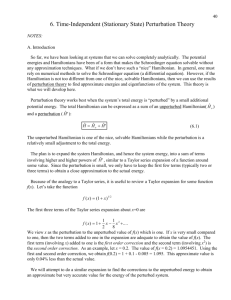Dr.Eman Zakaria Hegazy Quantum Mechanics and Statistical
advertisement
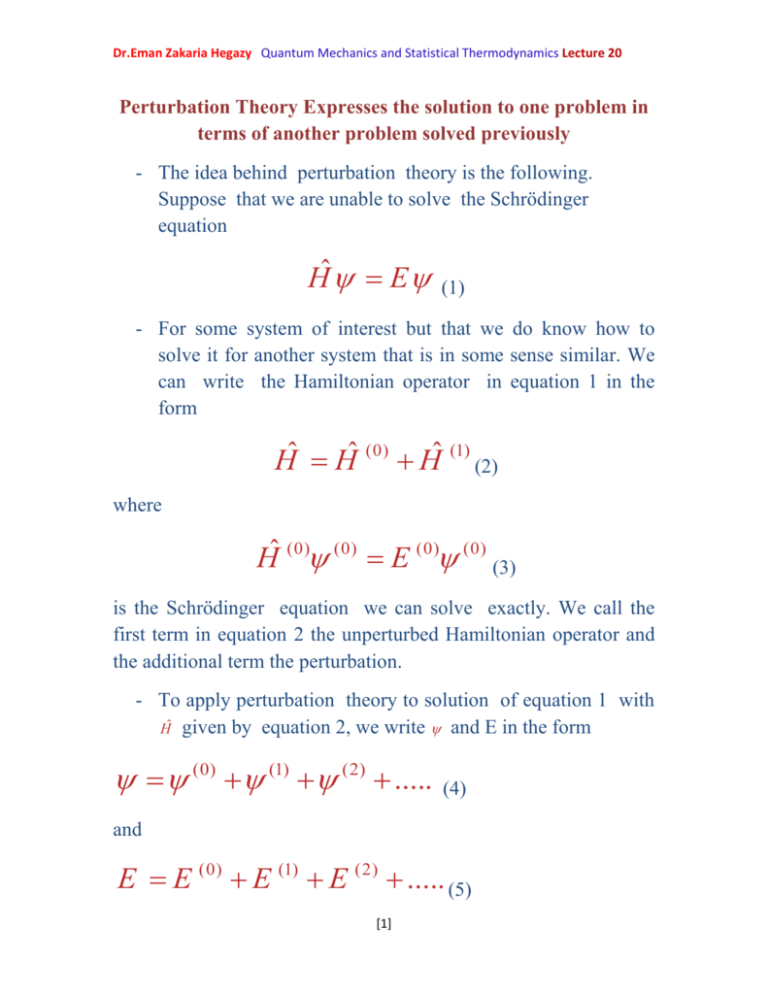
Dr.Eman Zakaria Hegazy Quantum Mechanics and Statistical Thermodynamics Lecture 20 Perturbation Theory Expresses the solution to one problem in terms of another problem solved previously - The idea behind perturbation theory is the following. Suppose that we are unable to solve the Schrödinger equation Hˆ E (1) - For some system of interest but that we do know how to solve it for another system that is in some sense similar. We can write the Hamiltonian operator in equation 1 in the form Hˆ Hˆ (0) Hˆ (1) (2) where Ĥ (0) (0) E (0) (0) (3) is the Schrödinger equation we can solve exactly. We call the first term in equation 2 the unperturbed Hamiltonian operator and the additional term the perturbation. - To apply perturbation theory to solution of equation 1 with Hˆ given by equation 2, we write and E in the form (0) (1) (2) ..... (4) and E E (0) E (1) E (2) ..... (5) [1] Dr.Eman Zakaria Hegazy Quantum Mechanics and Statistical Thermodynamics Lecture 20 where (0) and E(0) are given by the solution to unperturbed problem equation (3) and (1) , (2) ,..... are successive correction to (0) and E(1), E(2),…. are successive corrections to E(0). A baic assumption is that theses successive corrections become increasingly less significant. Although we will not do so here, we can derive explicit expressions for these corrections. The only one we will use is the expression for E(1) , which is E (1) (0)*Hˆ (1) (0)d (6) we say that E(1) is the first –order correction to E(0) , and we write E E (0) E (1) (7) Equation 7 represents the energy through first order perturbation theory. If we were to evaluate (1) (which we will not), then (0) (1) (8) Would represent through first order. Similarly, if we were to evaluate E (2) (which we will not), then E E (0) E (1) E (2) Would represent E through second order perturbation theory. In this book, we evaluate E to first order only, using equation 6. [2] Dr.Eman Zakaria Hegazy Quantum Mechanics and Statistical Thermodynamics Lecture 20 Perturbation theory to calculate the energy of a particle in box - We will use first order perturbation theory to calculate the energy of a particle in box from x=0 to x=a with a slanted bottom, such that V (x ) V 0x a 0x a In this case, the unperturbed problem is a particle in a box and so V x Hˆ (1) 0 a 0x a Where V0 is a constant. The wave functions and the energies for a particle in a box are n x 2 sin a a 12 (0) 0x a and E (0) n 2h 2 8ma 2 According to equation 6 , the first order correction of E(0) due to perturbation is given by V (0)* 0 x (0) dx a 0 a E (1) 2V 0 2 n x x sin dx a 2 0 a a = [3] Dr.Eman Zakaria Hegazy Quantum Mechanics and Statistical Thermodynamics Lecture 20 This integral occurs previously and is equal to a2/4. Therefore, we find that E (1) V0 2 For all values of n. the energy levels are given through first order by n 2h 2 V 0 2 E + +O(V ) n=1,2,3,.... 0 2 8ma 2 Where the term O (V02) emphasizes that terms of order V02 and higher have been dropped. Thus, we see in this case that each of the unperturbed energy levels s shifted by V0/2. [4] Dr.Eman Zakaria Hegazy Quantum Mechanics and Statistical Thermodynamics Lecture 20 Helium atom - We can apply perturbation theory to the helium atom whose Hamiltonian operator is given by equation 2 2 2 2 e 1 1 e 1 Hˆ ( ) ( ) 2m e 4 0 r1 r2 4 0 r12 2 1 2 2 For simplicity we will consider only the ground –state energy. If we consider the interelectronic repulsion term e2 4 0 r12 , to be the perturbation , then the unperturbed wave fnctions and energies are the hydrogenlike quantities given by Hˆ (0) Hˆ (1) Hˆ (2) (0) 1s (r1 ,1 , 1 ) 1s (r2 , 2 , 2 ) E (0) (9) Z 2 mee 4 Z 2 mee 4 32 2 0 2 n12 32 2 0 2 n 22 and Hˆ (1) e2 4 0 r12 with Z= 2. Using Equation (6), we have E (1) dr1dr2 1s (r1 ) 1s (r2 ) where [5] e2 1s (r1 ) 1s (r2 ) (10) 4 0 r12 Dr.Eman Zakaria Hegazy Quantum Mechanics and Statistical Thermodynamics Lecture 20 1/2 Z3 zr / a 1s (r j ) 3 e j 0 a0 The final result is that E (1) 5Z 8 me e 4 2 2 16 0 2 (11) 1 1 5 E E (0) E (1) Z 2 Z 2 Z 2 2 8 5 Z 2 Z 8 (12) - Letting Z= 2 gives -2.750 compared with our simple variational result (-2.8477) and the experimental results of 2.9033. - So we see that first order perturbation gives a result is about 5% in error. It turns out that second order perturbation theory gives -2.910 - Thus, we see that both the variational method and the perturbation theory are able to achieve very good results. [6]
